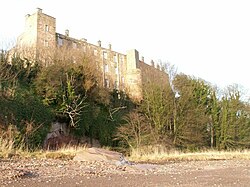Wemyss Castle
| Wemyss Castle | |
| Fife | |
|---|---|
 Wemyss Castle | |
| Location | |
| Grid reference: | NT32949513 |
| Location: | 56°8’39"N, 3°4’51"W |
| History | |
| Information | |
| Owned by: | The Earl of Wemyss |
Wemyss Castle (pronounced [weems]) stands on the sea cliffs between the villages of East Wemyss and West Wemyss in Fife.
History
Accounts date the construction of the castle to 1421 when Sir John Wemyss decided to build a fortified castle to replace one destroyed by the Duke of Rothesay at Kilconquhar in 1402. The castle is thus the ancient seat of the Earls of Wemyss and their families. Historically, the castle is perhaps best known as the location where Mary, Queen of Scots, met her future husband Lord Darnley, on 17 February 1565.[1]
The court of King James VI stayed at Wemyss Castle in July 1583.[2] On 11 May 1590 a party of Danish commissioners led by Peder Munk and the lawyer John Skene stayed at Wemyss Castle. Their task was to view and take sasine of Falkland Palace and Dunfermline Palace and Linlithgow Palace, the properties given to Anne of Denmark by James VI as a "morning gift" after their wedding.[3]
In April 1591 King James had Lilias (or Sophia) Ruthven, a daughter of William Ruthven, 1st Earl of Gowrie, shut away in Wemyss Castle to prevent her marrying Ludovic Stewart, 2nd Duke of Lennox. Lennox managed to get his bride out of the castle and marry her at Dunkeld, and after 10 days the king allowed the couple to come to court.[4]
In 1592 Sir John Wemyss of Wemyss provided a refuge at the castle for the queen's Danish lady-in-waiting Margaret Winstar whose partner John Wemyss of Logie had plotted with Francis Stewart, 5th Earl of Bothwell against the king.[5]
John Wemyss was obliged to keep prisoners for the king at Wemyss, including in 1597 Archie Armstrong of Whitehaugh in the unquiet borders. Wemyss and other Lairds complained about this duty, and in April James VI wrote to him and asked him to bring Armstrong as a prisoner to be kept at Falkland Palace instead.[6]
In the 1890s the nearby Coaltown of Wemyss was established as an estate village on land belonging to Wemyss Castle, in order to house mineworkers employed in several coal mines in the area.[7]
Architecture
Wemyss is an imposing castle sitting high atop cliffs with a view over the Firth of Forth. Two particular points of interest are that one of the towers from an earlier building has been re-used, first as a windmill and later as a dovecote. There is also an oval-shaped dungeon within the castle, connected to the building by a 30m zigzag passage. Wemyss castle was restored in the 1950s and remains a residence. Members of today's Royal Family, including the Queen, have visited.
Outside links
References
- ↑ Calendar State Papers Scotland, vol. 2 (Edinburgh, 1900), pp. 125-6.
- ↑ Bowes Correspondence (London, 1842), p. 496.
- ↑ David Stevenson, Scotland's Last Royal Wedding(Edinburgh, 1997), pp. 100-101, 103: William Fraser, Memorials of the family of Wemyss of Wemyss, vol. 3 (Edinburgh, 1888), pp. 28-9.
- ↑ Adrienne McLaughlin, 'Rise of a Courtier', Miles Kerr-Peterson & Steven Reid, eds, James VI and Noble Power in Scotland (Abingdon, 2017), pp. 147-8: Calendar State Papers Scotland: 1589-1593, vol. 10 (Edinburgh, 1936), p. 502.
- ↑ William Fraser, Memorials of the family of Wemyss of Wemyss, vol. 1 (Edinburgh, 1888), pp. 178-9.
- ↑ HMC 3rd Report, Wemyss (London, 1872), p. 422.
- ↑ Gifford, John. (2003). Fife.. Yale University Press. p. 127. ISBN 0-300-09673-9. OCLC 475440850. http://worldcat.org/oclc/475440850.